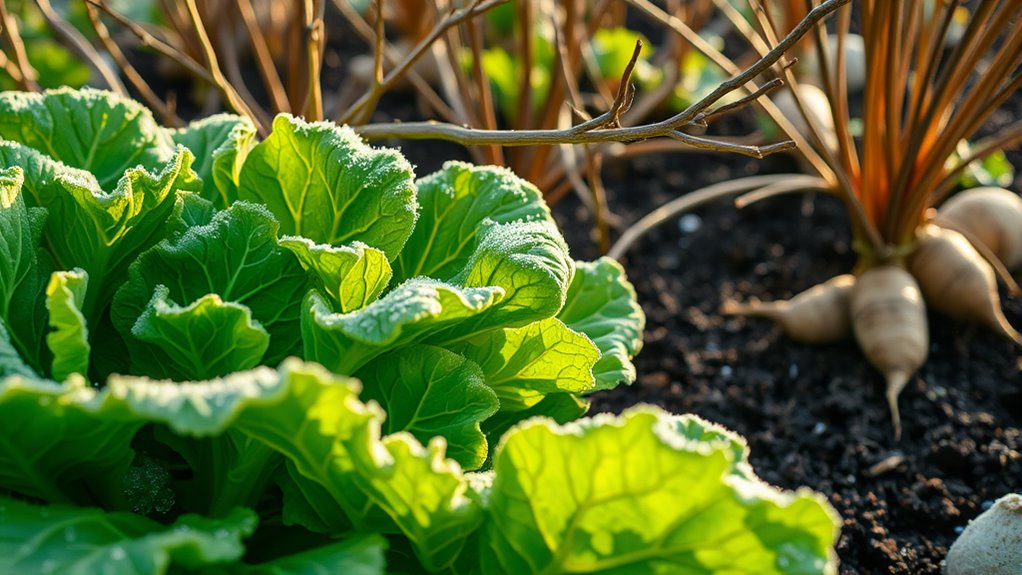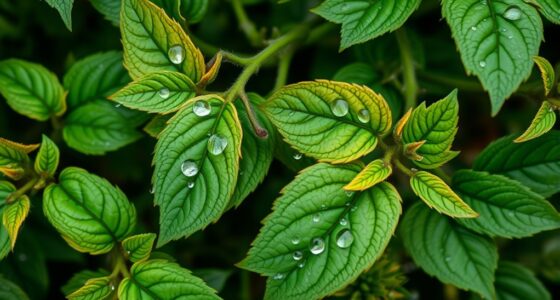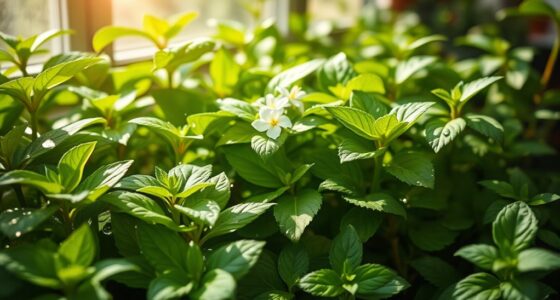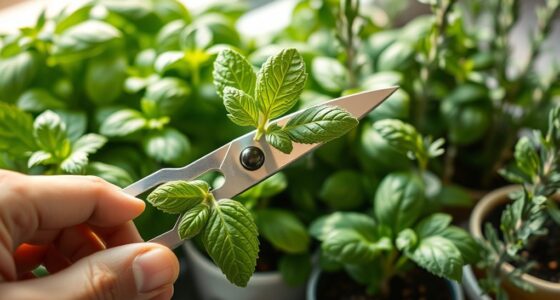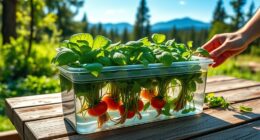To support winter growth, adjust your plant’s nutrients by reducing nitrogen and increasing potassium and phosphorus to strengthen roots. Use proper lighting—either natural sunlight or full-spectrum grow lights—to mimic longer days and boost photosynthesis. Protect outdoor plants from frost with covers and mulch, and move potted plants indoors if possible. Balancing light and nutrients helps plants stay healthy through cold months, and exploring further tips can optimize your winter gardening success.
Key Takeaways
- Reduce nitrogen fertilization and focus on potassium and phosphorus to strengthen roots and improve winter resilience.
- Use slow-release organic fertilizers to provide steady nutrients during dormant periods.
- Extend light exposure with full-spectrum grow lights to compensate for shorter winter days and support photosynthesis.
- Protect plants with mulching and coverings to insulate roots and prevent cold stress.
- Adjust watering to maintain soil moisture without overwatering, reducing the risk of root rot during winter months.
Understanding Plant Needs During Winter
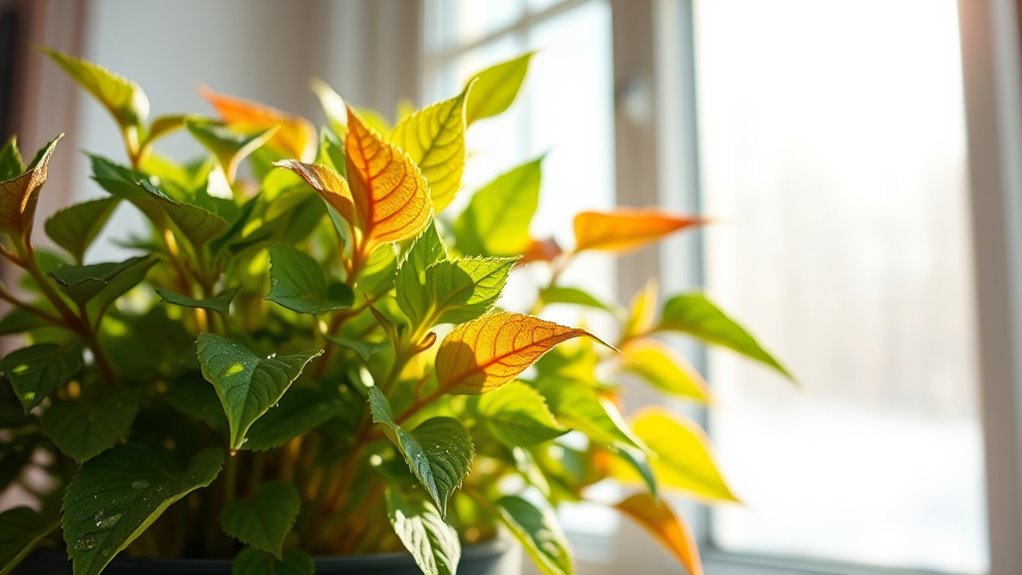
During winter, plants face harsher conditions that can threaten their health, making it essential to understand their specific needs during this season. Many plants enter a period of plant dormancy, slowing their growth and conserving energy to survive the cold months. During dormancy, root development continues underground, albeit at a reduced pace, which helps plants establish a strong foundation for spring growth. You should avoid disturbing roots during this time, as they are crucial for nutrient uptake and stability. Ensuring proper protection from frost and maintaining minimal disturbance allows roots to develop steadily. Recognizing when your plants are in dormancy helps you provide the right environment, preventing stress and encouraging healthy growth once conditions improve. Understanding plant dormancy is key to supporting your plants through the winter months.
Adjusting Nutrient Ratios for Cold Months
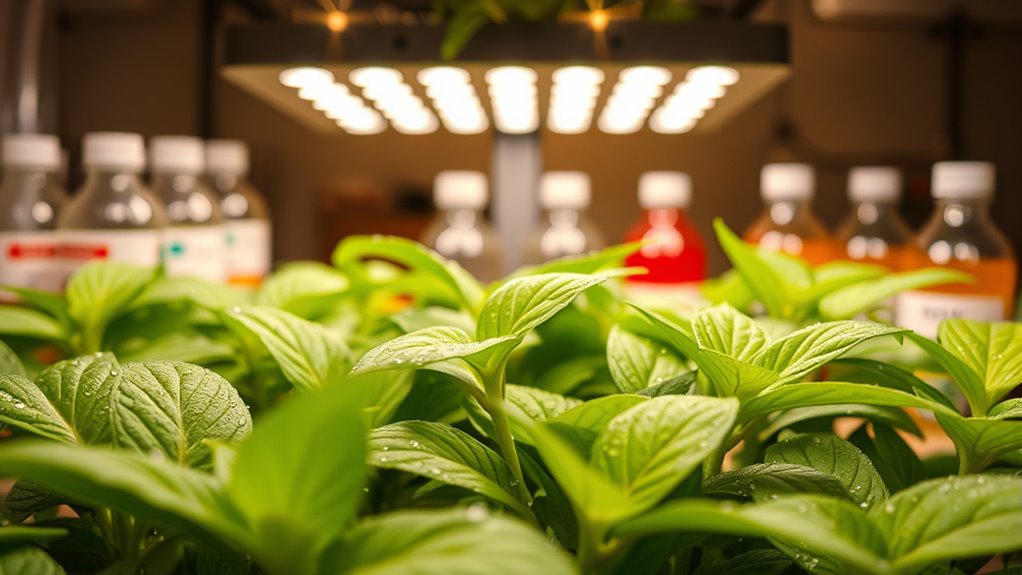
As the cold months approach, adjusting your plants’ nutrient ratios becomes essential to support their wintering needs. To optimize growth, consider these strategies:
- Incorporate soil amendments rich in potassium and phosphorus to strengthen root systems and improve cold tolerance.
- Adjust your watering schedules to prevent overwatering, which can lead to root rot in low temperatures, while maintaining adequate moisture.
- Balance nitrogen levels carefully; reduce excessive nitrogen, which promotes lush growth vulnerable to cold damage, and instead promote sturdier, slower growth.
- Ensuring proper soil drainage is vital during winter to prevent water accumulation around roots, which can cause root rot and stress.
These steps ensure your plants receive the proper nutrients without stressing them during winter. By tailoring soil amendments and watering routines, you help your plants adapt, grow resilient, and prepare for the upcoming seasons.
The Role of Light Intensity and Duration
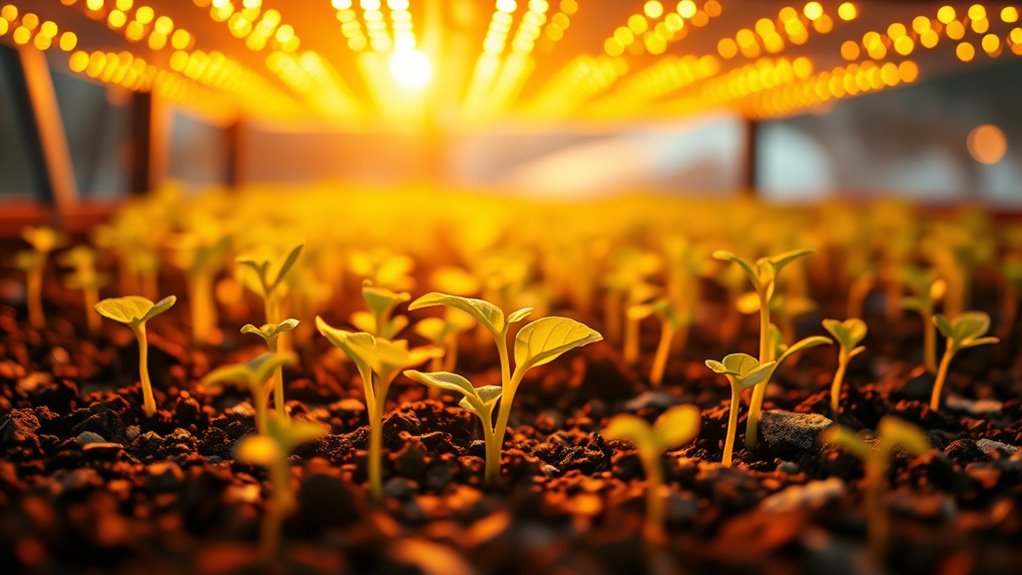
You’ll notice that longer daylight hours and increased light intensity can boost plant growth during the seasons. When you adjust light duration, you influence flowering and development cycles, making them more in sync with the environment. Understanding how light impacts growth helps you optimize your plants’ health year-round.
Light Duration Effects
Light duration plays a crucial role in influencing biological processes, as the length of daily light exposure can trigger significant changes in behavior and physiology. Extended light periods enhance photosynthesis efficiency, allowing plants to produce more energy during winter. Additionally, the light spectrum interacts with duration to affect growth patterns; specific wavelengths optimize photosynthetic responses. Consider these effects:
- Longer light exposure increases overall energy capture, boosting plant vigor.
- The duration influences hormone regulation, impacting flowering and dormancy cycles.
- Variations in light spectrum during extended periods can shift metabolic pathways, improving nutrient uptake and stress resilience.
- Properly managed light duration can also help mimic natural seasonal cues, supporting healthy plant development and precious metals investment strategies for long-term growth.
Intensity and Growth
Building on how light duration influences plant processes, the intensity of that light also markedly impacts growth. Higher light intensity enhances light penetration into the plant’s canopy, allowing more energy to reach each leaf. This boosts photosynthesis, leading to stronger, faster-growing plants. Conversely, low light intensity limits light penetration, reducing photosynthetic efficiency and slowing growth. Your plant’s response depends on its photoperiod, or the length of daily light exposure, but intensity amplifies this effect. During winter, increasing light intensity can help compensate for shorter days, promoting healthy development. Understanding how light penetration interacts with plant photoperiod allows you to optimize growth conditions, ensuring your plants receive enough energy to thrive despite seasonal changes. Additionally, maintaining appropriate light levels is crucial for preventing stress and encouraging optimal growth during the darker months.
Choosing the Right Artificial Lighting Solutions
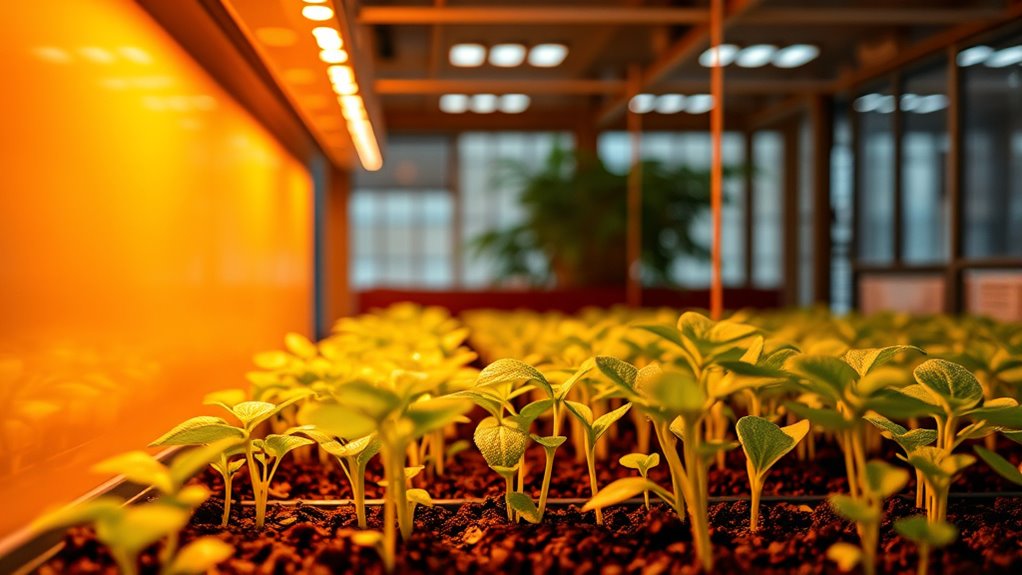
Have you ever wondered how to choose the best artificial lighting for your space? The right solution depends on understanding your plants’ needs and how to optimize light use. First, consider the LED spectrum; full-spectrum LEDs mimic natural sunlight, promoting healthy growth. Second, think about light placement; position lights at the correct height and angle to ensure even coverage without causing heat stress. Third, evaluate the type of light fixture—whether it’s a panel, bulb, or strip—to match your space’s size and plant requirements. Properly selecting and positioning your lighting guarantees your plants receive the necessary spectrum and intensity, especially during winter months. Incorporating natural materials into your setup can enhance the overall environment and support plant health, making informed choices that help promote vibrant growth and prevent issues like leggy stems or poor development.
Managing Light Exposure for Indoor and Outdoor Plants
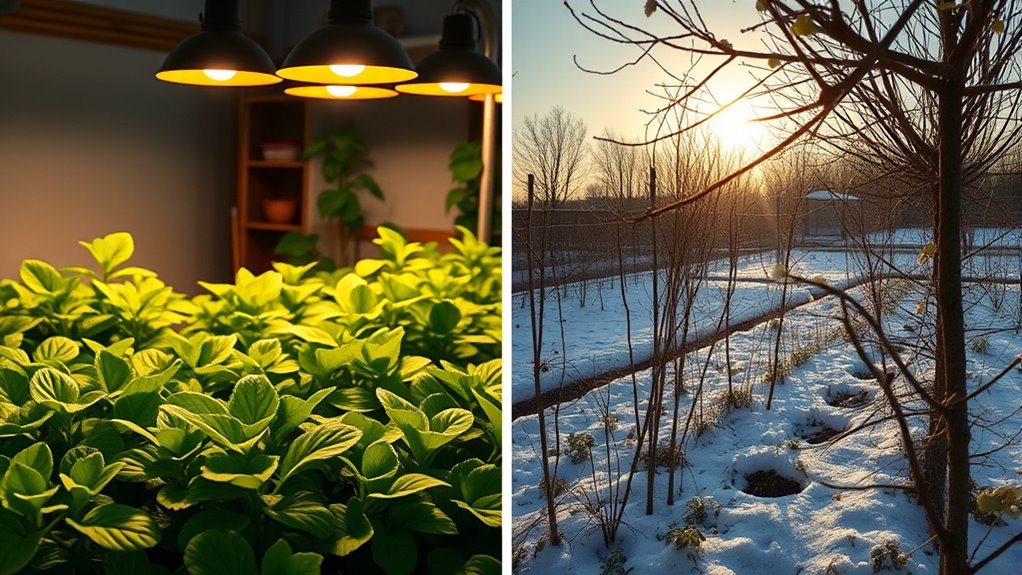
Adjusting light exposure is key to ensuring your plants thrive both indoors and outdoors. Proper shade management helps prevent sunburn and stress, especially during winter when sunlight is weaker and days are shorter. For outdoor plants, position shade cloths or plant barriers to control direct sunlight, giving your plants just the right amount of light. Indoors, use grow lights that mimic the natural light spectrum, ensuring your plants receive balanced wavelengths for healthy growth. Rotate potted plants regularly to prevent uneven light exposure. By managing shade and selecting appropriate light spectrum, you optimize photosynthesis and promote robust winter growth. Additionally, understanding the importance of light spectrum can significantly influence your plant’s health and growth rate during seasonal changes. Remember, tailored light exposure supports your plants’ overall health and resilience through seasonal changes.
Soil Preparation and Fertilization Tips for Winter
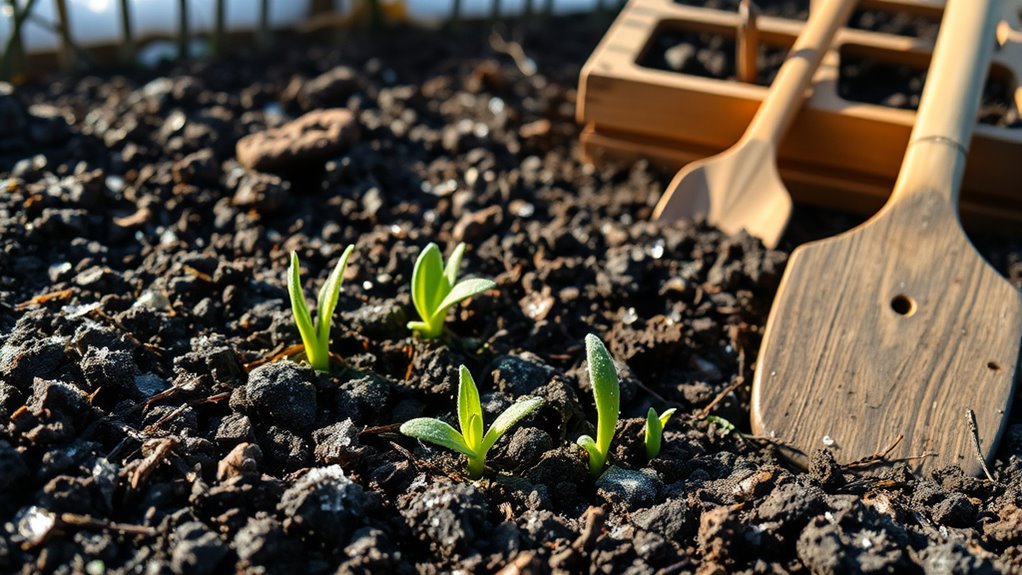
As winter approaches, preparing your soil and fertilizing properly can substantially boost your plants’ health through the cold months. Focus on improving soil texture by adding organic matter, which enhances drainage and aeration. This helps maintain microbial activity, essential for nutrient availability. To optimize soil conditions, consider these steps:
- Test soil pH and adjust if necessary to ensure nutrients are accessible.
- Incorporate compost or well-rotted manure to enrich organic content.
- Apply a slow-release fertilizer to provide steady nutrients during winter.
- Using amendments like bone meal or rock phosphate can further enhance soil fertility and help plants access phosphorus during colder months.
These actions encourage healthy microbial activity and create a resilient environment for roots. Proper soil preparation guarantees your plants stay strong, resist cold stress, and are ready to thrive as conditions improve.
Monitoring and Preventing Nutrient Deficiencies
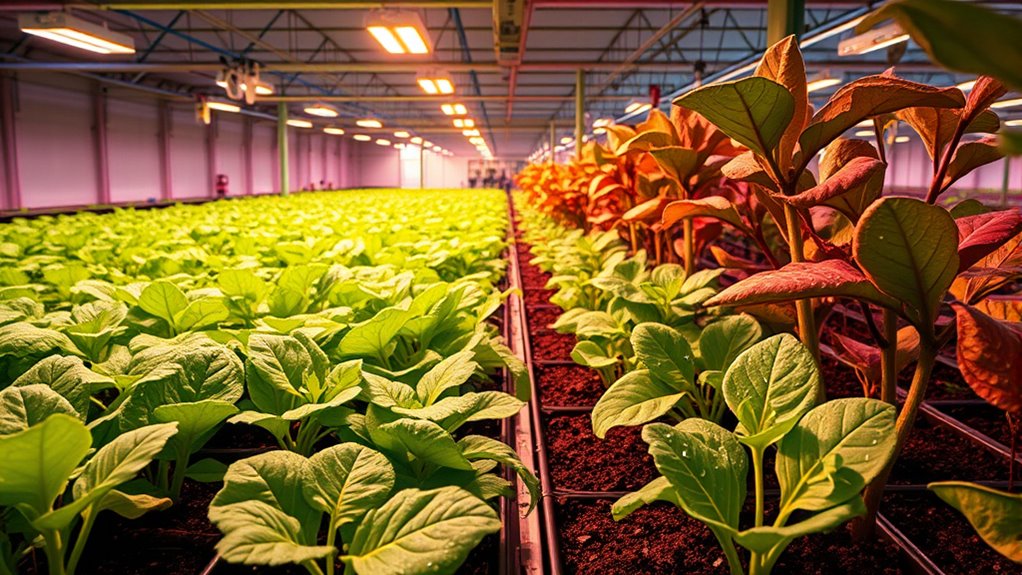
Monitoring your soil and plant health during winter helps catch nutrient deficiencies early, ensuring your garden stays vigorous despite the cold. Regular soil testing reveals nutrient gaps before plants show signs of stress, allowing you to adjust treatments promptly. Keep an eye on yellowing leaves, stunted growth, or poor flowering, which can indicate deficiencies in nitrogen, magnesium, or other nutrients. Prevent deficiencies by maintaining proper pH levels and avoiding overwatering, which can cause nutrient lockout. Additionally, pest control is crucial, as pests can weaken plants and make them more vulnerable to nutrient shortages. Using electric dirt bikes for garden tasks can also help reduce soil compaction, promoting better root growth. By staying vigilant, you can address issues quickly, applying targeted solutions that keep your plants healthy and resilient throughout the winter months.
Using Organic and Synthetic Fertilizers Effectively
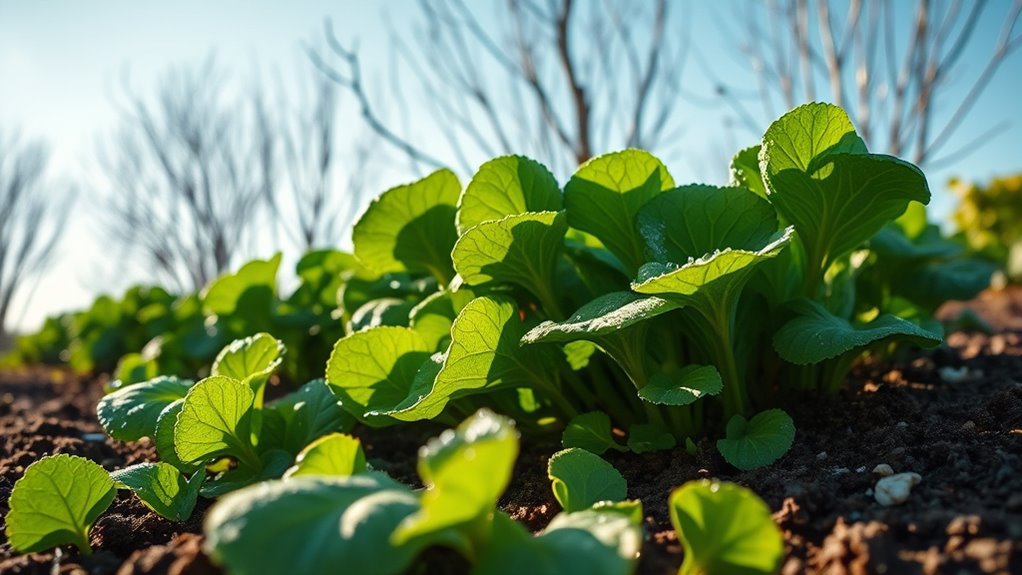
Choosing the right fertilizer depends on understanding the differences between organic and synthetic options. Timing and application methods can maximize their effectiveness, so it’s important to get those details right. Striking a balance between both types helps you meet your plants’ needs without over- or under-fertilizing.
Fertilizer Types Comparison
Organic and synthetic fertilizers each offer distinct advantages and considerations for growers seeking effective nutrient management. Organic options, like slow release fertilizers, provide gradual nutrient release, reducing runoff and promoting steady plant growth. Synthetic fertilizers deliver nutrients quickly, making them ideal for immediate corrections or rapid growth needs. When choosing between them, consider these factors:
- Application Method: Liquid feed options allow quick nutrient delivery, perfect for immediate needs.
- Release Timing: Slow release fertilizers support long-term feeding, especially in winter.
- Environmental Impact: Organic fertilizers tend to be more environmentally friendly, with fewer leaching concerns.
- Method of Delivery: Application techniques can influence how effectively nutrients are absorbed and utilized by plants.
Balancing these approaches helps optimize plant health and growth during winter’s unique conditions.
Timing and Application Tips
To use organic and synthetic fertilizers effectively, timing your applications is essential for maximizing nutrient uptake and minimizing waste. Apply fertilizers when plants are actively growing, typically in early morning or after watering, to enhance absorption. Adjust your watering frequency to avoid overwatering or underwatering, which can hinder nutrient availability. For organic fertilizers, apply them gradually, allowing time for soil microorganisms to break down nutrients. With synthetic fertilizers, follow label instructions closely to prevent nutrient runoff and pest management issues. Avoid fertilizing before heavy rain to prevent leaching. Proper timing helps guarantee nutrients reach roots efficiently and reduces the risk of attracting pests or diseases. Additionally, understanding the timing of nutrient availability can optimize plant growth during winter months. Consistent, thoughtful application supports healthy winter growth and overall plant vigor.
Balancing Organic and Synthetic
Effectively balancing organic and synthetic fertilizers involves understanding how each interacts with your soil and plants. Organic fertilizers improve soil aeration and foster beneficial microbes, but release nutrients slowly. Synthetic options offer immediate nutrient availability, which can boost plant growth quickly. To optimize their use, consider:
- Applying organic fertilizers first to build healthy soil structure and enhance pest management.
- Using synthetic fertilizers strategically during peak growth periods for quick nutrient boosts.
- Monitoring soil health regularly to avoid over-fertilization, which can impair soil aeration and encourage pests.
- Incorporating principles of somatic therapy, such as mindful observation of physical sensations, to better gauge the plant’s responses and overall soil vitality.
Protecting Plants From Cold Stress and Frost
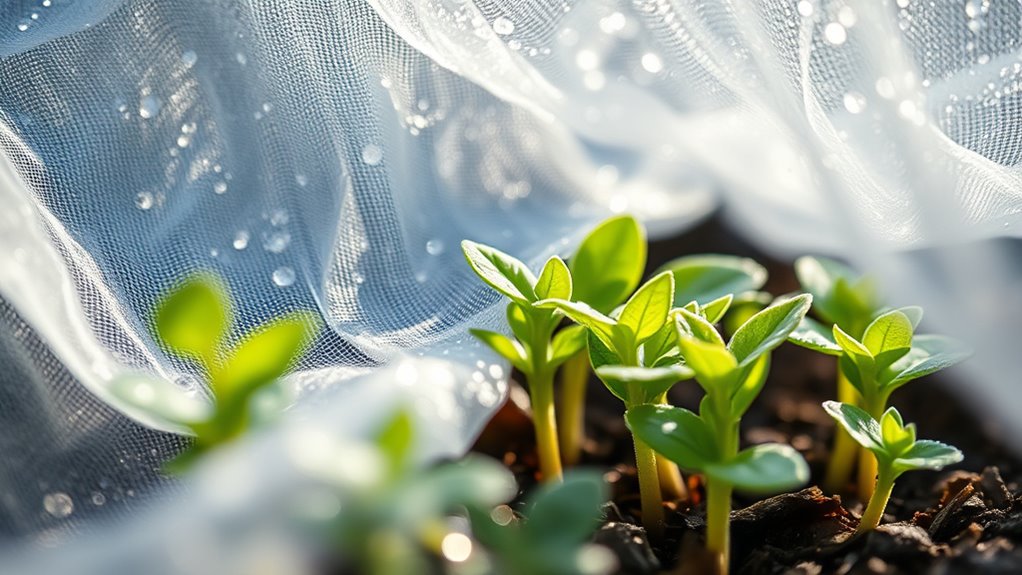
As temperatures drop unexpectedly, protecting your plants from cold stress and frost becomes essential to prevent damage. Understanding plant hardiness helps you determine which plants need extra protection and when. To guarantee frost protection, cover vulnerable plants with blankets, burlap, or frost cloths before nightfall. Mulching around roots insulates the soil, maintaining consistent temperatures. Moving potted plants indoors or to sheltered areas can also prevent frost damage. Watering plants before a freeze adds moisture to the soil, which can help insulate roots. Remember, early intervention is key; don’t wait until the cold has already set in. Taking these steps will help your plants withstand chilly conditions and survive the winter, preserving their health until spring. Necessary cookies and other cookie categories can be tailored to support your plant care routine.
Planning a Winter Growth Schedule for Optimal Results
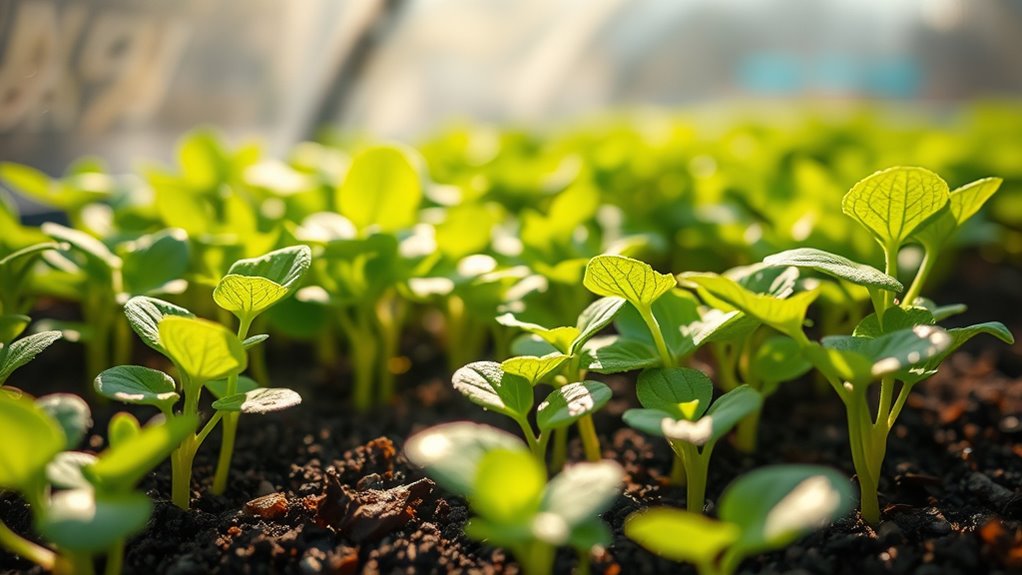
Planning a winter growth schedule is essential for ensuring your plants thrive despite the colder months. To do this effectively, focus on three key steps. First, select frost resistant varieties that can withstand low temperatures, reducing the risk of damage. Second, incorporate strategic winter pruning to remove dead or weak branches, encouraging healthy growth and airflow. Third, adjust your watering schedule to prevent overwatering, as roots can be more vulnerable to cold. Keep in mind that timing is critical; plan pruning and planting times to align with the coldest periods. Additionally, understanding plant resilience can help you better prepare your garden for winter conditions. By following these steps, you optimize your plants’ resilience and growth potential, even during winter’s challenges. Proper planning guarantees your garden stays healthy and productive year-round.
Frequently Asked Questions
How Do Seasonal Adjustments Impact Plant Disease Susceptibility?
Seasonal adjustments can influence plant disease susceptibility by affecting their overall health and pathogen resistance. When you modify nutrients and light, you help plants strengthen their immune responses, reducing the risk of disease. Proper disease prevention involves maintaining ideal conditions through seasonal changes. By doing so, you support your plants’ natural defenses, making them less vulnerable to pathogens and improving their ability to resist infections during different seasons.
Can Artificial Lighting Fully Replace Natural Sunlight in Winter?
Think of artificial lighting as a painter’s palette, offering vibrant colors to recreate sunlight indoors. In indoor cultivation, LED technology can effectively mimic natural sunlight, providing plants with essential wavelengths during winter. While it might not fully replicate the sun’s full spectrum, LED lights can support healthy growth, ensuring your plants thrive despite the darker days. So, yes, LED technology can bridge the gap, but understanding its limits helps optimize your indoor garden.
What Are Signs of Nutrient Imbalance During Winter Growth?
During winter growth, nutrient imbalance shows up through signs like leaf discoloration, which indicates issues like fertilizer deficiency. You might notice yellowing or browning leaves, stunted growth, or weak stems. These symptoms tell you your plants aren’t getting the right nutrients. To fix this, check your fertilization schedule and make certain you’re providing balanced nutrients suited for winter conditions. Proper nutrition helps maintain healthy growth despite shorter days and lower light levels.
How Does Winter Pruning Influence Nutrient Uptake?
Winter pruning helps improve nutrient uptake by promoting better root health and airflow. When you prune, you reduce plant stress, allowing roots to focus on nutrient absorption and storage. Proper fertilizer timing after pruning boosts this process, ensuring your plants get essential nutrients during winter. Keep in mind, healthy roots are key to better nutrient uptake, so avoid over-pruning and apply fertilizer thoughtfully for ideal winter growth.
Are There Specific Plant Varieties Better Suited for Winter Growth?
You’ll find that hardy varieties and winter tolerant cultivars are better suited for winter growth. These plants are naturally more resilient to cold temperatures, snow, and low light conditions. By choosing these types, you guarantee your garden survives harsh weather and remains healthy through winter. Look for varieties specifically bred for winter hardiness, and you’ll enjoy vibrant, thriving plants even during the coldest months.
Conclusion
Think of winter as a delicate dance between light and nutrients, where every step counts. By adjusting your plant’s diet, lighting, and protection strategies, you create a cozy greenhouse in nature’s chill. Stay attentive to their needs, monitor closely, and adapt as seasons shift. With careful planning, you’ll keep your plants thriving through winter’s hush, transforming this cold season into a vibrant chapter of growth—your garden’s quiet symphony in the making.
